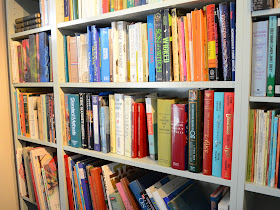When it actually came time to build our new shelves and paint our old ones, I decided to used oil-based paint to do it. Obviously, there are pros and cons to any product, and oil-based paint has a lot of cons. You probably already are naming them to yourself, since virtually no one uses it now except crazy old me. But I do often use it on furniture, and I'll go ahead and tell you why.
First, the Cons: ( you know these)
- It's stinky and has all the VOCs. (Okay, I really don't know if that's true, but it sure is stinky.)
- It has a long dry time, as in, 24+ hours, and is therefore prone to drips, and you don't get that instant gratification that we all love.
- It is a pain to clean up. Bring on the paint thinner/mineral spirits when you're using oil-based paint or force yourself to use disposable everything.
- It's hard to find because no one (but me) uses it any more.
- It has a long dry time. I know I just said that was a con, but that also means it's pretty self-leveling, leaving you gorgeous smooth finishes, and also means you have working time for mistakes, fixing those drips, etc. My bookshelves were full of bubbles from the foam rollers (though I did my best to smooth them out) but by the time it was dry, there were no bubbles left. Amazing. A paint that fixes my mistakes. (Not really)
- It dries rock hard. Okay, so I haven't done scientific tests on this, but I do know that when I paint furniture, especially horizontal surfaces with it, papers, magazines, etc, do not stick to it, and that is what I'm looking for when I'm painting tables, bookshelves, and desks. (**Though I do have a couple of water-based options for this)
The 2 solutions I’ve ever found for this (so far) are oil-based paint or polyurethane, more specifically, Minwax’s water-based Polycrylic, but I’ll do another post on that later. (Though, I did just read in Young House Love, that they used a new alkyd paint by Benjamin Moore that's water clean-up and sounds great! I'll have to test it one day and report!) One reason I chose not to use Polycrylic this time is that it is another step. Sure, oil-based paint has a long-ass dry time, but I just have to step back and let it dry, not get out another set of tools to put on the clear coat.
Now, oil-based paint is hard to find. I use floor paint (like Valspar’s Oil-Gloss floor paint) or Rustoleum. Rustoleum has limited colors, and even more limited colors that come in a satin finish. The Valspar floor paint can be tinted to pretty much any color, but only comes in gloss. And I mean gloss. About 6 years ago, I got some tintable (well, they tinted it for me) satin-finish oil-based paint at a local paint store, but I haven’t tried since then.
(I really do want to test this new Benjamin Moore paint and report! My concern isn't just durability, but magazine-stickiness. You know what I mean.)
My tips for using oil-based paint: Stock up on mineral spirits. Be willing to ditch your brush. Open a window and put a fan blowing out in it (to suck out the stinky air!). Put on lots of cheerful music to help your sanity. Enjoy thinking about how great your project will be when it's done.


No comments:
Post a Comment